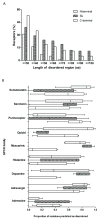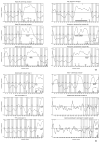Functional characterization of G-protein-coupled receptors: a bioinformatics approach
- PMID: 24997265
- PMCID: PMC4164567
- DOI: 10.1016/j.neuroscience.2014.06.049
Functional characterization of G-protein-coupled receptors: a bioinformatics approach
Abstract
Complex molecular and cellular mechanisms regulate G protein-coupled receptors (GPCRs). It is suggested that proteins intrinsically disordered regions (IDRs) are to play a role in GPCR's intra and extracellular regions plasticity, due to their potential for post-translational modification and interaction with other proteins. These regions are defined as lacking a stable three-dimensional (3D) structure. They are rich in hydrophilic and charged, amino acids and are capable to assume different conformations which allow them to interact with multiple partners. In this study we analyzed 75 GPCR involved in synaptic transmission using computational tools for sequence-based prediction of IDRs within a protein. We also evaluated putative ligand-binding motifs using receptor sequences. The disorder analysis indicated that neurotransmitter GPCRs have a significant amount of disorder in their N-terminus, third intracellular loop (3IL) and C-terminus. About 31%, 39% and 53% of human GPCR involved in synaptic transmission are disordered in these regions. Thirty-three percent of receptors show at least one predicted PEST motif, this being statistically greater than the estimate for the rest of human GPCRs. About 90% of the receptors had at least one putative site for dimerization in their 3IL or C-terminus. ELM instances sampled in these domains were 14-3-3, SH3, SH2 and PDZ motifs. In conclusion, the increased flexibility observed in GPCRs, added to the enrichment of linear motifs, PEST and heteromerization sites, may be critical for the nervous system's functional plasticity.
Keywords: GPCR; disordered proteins; linear motifs; noncovalent interactions; pest motifs.
Published by Elsevier Ltd.
Conflict of interest statement
Dr Rohde was on the speakers’ bureau and/or acted as consultant for Eli-Lilly, Janssen-Cilag, Novartis and Shire in the last 3 years. The ADHD and Juvenile Bipolar Disorder Outpatient Programs chaired by him received unrestricted educational and research support from the following pharmaceutical companies in the last 3 years: Abbott, Eli-Lilly, Janssen-Cilag, Shire and Novartis. He also receives royalties for authorship from ArtMed and Oxford Press.
Figures



Similar articles
-
Phosphorylation motif dictates GPCR C-terminal domain conformation and arrestin interaction.Structure. 2023 Nov 2;31(11):1394-1406.e7. doi: 10.1016/j.str.2023.08.011. Epub 2023 Sep 4. Structure. 2023. PMID: 37669668
-
Cholesterol interaction motifs in G protein-coupled receptors: Slippery hot spots?Wiley Interdiscip Rev Syst Biol Med. 2020 Jul;12(4):e1481. doi: 10.1002/wsbm.1481. Epub 2020 Feb 7. Wiley Interdiscip Rev Syst Biol Med. 2020. PMID: 32032482 Review.
-
The Open Question of How GPCRs Interact with GPCR Kinases (GRKs).Biomolecules. 2021 Mar 17;11(3):447. doi: 10.3390/biom11030447. Biomolecules. 2021. PMID: 33802765 Free PMC article.
-
The study of G-protein coupled receptor oligomerization with computational modeling and bioinformatics.FEBS J. 2005 Jun;272(12):2926-38. doi: 10.1111/j.1742-4658.2005.04730.x. FEBS J. 2005. PMID: 15955053 Review.
-
Unraveling the Functional Significance of Unstructured Regions in G Protein-Coupled Receptors.Biomolecules. 2023 Sep 22;13(10):1431. doi: 10.3390/biom13101431. Biomolecules. 2023. PMID: 37892113 Free PMC article. Review.
Cited by
-
Computational Analysis of Missense Variants of G Protein-Coupled Receptors Involved in the Neuroendocrine Regulation of Reproduction.Neuroendocrinology. 2016;103(3-4):230-9. doi: 10.1159/000435884. Epub 2015 Jun 18. Neuroendocrinology. 2016. PMID: 26088945 Free PMC article.
-
G-protein-coupled receptors mediate 14-3-3 signal transduction.Signal Transduct Target Ther. 2016 Sep 30;1:16018. doi: 10.1038/sigtrans.2016.18. eCollection 2016. Signal Transduct Target Ther. 2016. PMID: 29263900 Free PMC article.
-
Receptor-Receptor Interactions as a Widespread Phenomenon: Novel Targets for Drug Development?Front Endocrinol (Lausanne). 2019 Feb 18;10:53. doi: 10.3389/fendo.2019.00053. eCollection 2019. Front Endocrinol (Lausanne). 2019. PMID: 30833931 Free PMC article. Review.
-
The Listeriolysin O PEST-like Sequence Co-opts AP-2-Mediated Endocytosis to Prevent Plasma Membrane Damage during Listeria Infection.Cell Host Microbe. 2018 Jun 13;23(6):786-795.e5. doi: 10.1016/j.chom.2018.05.006. Cell Host Microbe. 2018. PMID: 29902442 Free PMC article.
-
ELM 2016--data update and new functionality of the eukaryotic linear motif resource.Nucleic Acids Res. 2016 Jan 4;44(D1):D294-300. doi: 10.1093/nar/gkv1291. Epub 2015 Nov 28. Nucleic Acids Res. 2016. PMID: 26615199 Free PMC article.
References
-
- Adams CL, Cowen MS, Short JL, Lawrence AJ. Combined antagonism of glutamate mGlu5 and adenosine A2A receptors interact to regulate alcohol-seeking in rats. Int J Neuropsychopharmacol. 2008;11(2):229–41. - PubMed
-
- Agnati LF, Ferre S, Lluis C, Franco R, Fuxe K. Molecular mechanisms and therapeutical implications of intramembrane receptor/receptor interactions among heptahelical receptors with examples from the striatopallidal GABA neurons. Pharmacol Rev. 2003;55(3):509–50. - PubMed
-
- Agnati LF, et al. Allosteric modulation of dopamine D2 receptors by homocysteine. J Proteome Res. 2006;5(11):3077–83. - PubMed
-
- Agnati LF, et al. Structural plasticity in G-protein coupled receptors as demonstrated by the allosteric actions of homocysteine and computer-assisted analysis of disordered domains. Brain Res Rev. 2008;58(2):459–74. - PubMed
Publication types
MeSH terms
Substances
Grants and funding
LinkOut - more resources
Full Text Sources
Other Literature Sources

